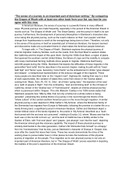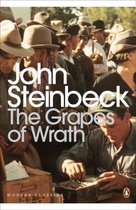“The sense of a journey is an important part of American writing.” By comparing
the Grapes of Wrath with at least one other book from your list, say how far you
agree with this view.
In American literature, the sense of a journey is a powerful theme in many different
ways. Physical journeys are made frequently, especially in the pursuit of the American Dream in
novels such as ‘The Grapes of Wrath’ and ‘The Great Gatsby’, and the pursuit in itself is its own
journey. Furthermore, the development of personal philosophies in Steinbeck’s characters also
occur along this physical journey, such as the Joad’s reliance on their “own people” and their
change from hopelessness to wrath at the wrongdoings being done to them. Therefore, not only
is the sense of the journey in itself an essential part of American literature, the lessons learned
and discoveries made are a prevalent theme in what makes the American people American.
To begin with, in ‘The Grapes of Wrath’, Steinbeck explores the physical journey of
internal migration made by families, such as the Joads, from the Dust Bowl to western states
like California and the impact of this upon them. During the 1930s Dust Bowl, a region of plains
that spanned the southern central United States, the failure of crops and the inability to compete
with newly mechanised farming methods drove people to migrate, Oklahoma itself losing
440,000 people during the 1930s. Steinbeck first depicts the difficulties of these migrants in the
personified “land turtle” that he describes in the second chapter, making its path with its “head
held high” and “fierce” eyes, becoming “more frantic” as the embankment it climbs “grew steeper
and steeper”, a metaphorical representation of the arduous struggle of the migrants. These
many people are described later on the “migrant road”, Highway 66, making their way to a land
of work opportunities, the variation of states they come from shown in the “license plates”,
coming from “Mass.,Tenn, RI, NY, Vt, Ohio”, all of them “going west.” His depiction of the road
as a “path of people in flight”, from the contrasting “dust and shrinking land” to the richness of
California, shown in the “shallow sea” of “fruit blossoms'', depicts an intense physical journey
which is paramount within ‘Grapes’. The critic Malcolm Cowley in his 1939 review states that
Steinbeck presents how “little by little, that not only a family but a whole culture is being
uprooted”, presenting this central theme of a journey in the novel through the theme of the
"whole culture" of the central southern American poor on the move through migration. A similar
physical journey is also depicted in Willa Cather’s ‘My Antonia’, where the Bohemian family of
the Shimerdas has migrated from Europe to Nebraska, following the promise of a better life on a
newly thriving land, a significant pursuit in American literature. Cather and Steinbeck depict a
similar biblical vision of the lands migrated to, the prairie in ‘My Antonia’ described as a “bush
that burned with fire and was not consumed”, relating to Exodus 3:2, where “Moses saw that the
bush was on fire but did not burn up”, and the land of California has a fertility similar to the
Garden of Eden, with “fruit ever’place” and “grapes...just ahangin’ over inta the road”, depicting
the American almost god-like visionary capability. The impact of these physical journeys is
similarly detrimental to the older generation, Cather’s Mr Shimerda finds himself “so unhappy”
from his “homesickness” that he dies, just as Steinbeck’s character of Granpa in ‘Grapes’ dies
soon after the Joads first leave their home. These two novels demonstrate the drive of the
working class to pursue better lives in richer places but also the harshness of this physical
journey of migration on the people. Thus migration as its own physical journey is not only an
important part of American literature, but in ‘The Grapes of Wrath’ proves essential in depicting
the realities of the poor’s experience of the American Dream.
, Alongside their migration, Steinbeck presents the drive of the Joads through their pursuit
of the American Dream and their disillusionment with it along their route. At the beginning of the
novel, the Joads hopefully look towards the land of California, where they can “all get jobs an’ all
work”, dreaming of the rich land where they can escape their debt accumulated during the
1930s Great Depression, their own caused in the Dust Bowl drought. Roosevelt addressed
America’s plan against the Great Depression with a similar American hopefulness, following the
1929 Wallstreet Crash, stating in his March 4th 1933 speech that it was time to “wage war
against the emergency”. Roosevelt proposed his New Deal with a series of programmes which
were to be carried out to ensure the economic restoration of America. This image of
hopefulness drives the Joads to pursue the happiness and work promised to them. However,
this sense of hope and dreaming steadily decreases through their journey to California, moved
from happiness, such as Granpa’s description of getting a “bathtub” full of “grapes”, to steadying
doubt in grounded characters like Ma, who “seemed to suddenly know it was all a dream”. The
hostility of the locals to the migrants, telling them that “we don’t want none of you settlin’ down
here” and having “whipped themselves into a mould of cruelty” is detrimental to the Joad family,
this harshness moving even Tom Joad to tears. The critic Malcolm Bradbury described the
American Dream as coming from a “dream of an innocent pastoral America created by a man’s
desire for wonder” and Steinbeck presents the initial possession of this "desire for wonder" and
it's deterioration further through the loss of family members on their journey. Granpa and
Granma die on the road before they even reach California, and the young men Noah and
Connie abandon the family as their desperation increases. There is a vivid contrast in the
hopeful vision at the beginning to the final scene of their homelessness, the “flood” coming to
wash away all they have worked for, and Roseharn’s baby being stillborn, reduced to a “blue
shrivelled little mummy”, presenting the final death of that vision. In ‘The Great Gatsby’, Scott
Fitzgerald presents a similar disillusionment with the main character, Gatsby’s, original dream.
Disillusionment with the American Dream is central in the novel, Fitzgerald describing from the
beginning a “foul dust that floated in the wake of his (Gatsby’s) dreams”. Fitzgerald indicates an
inevitable failure rooted in any sort of pursuit that mirrors the American search for success and,
this “dust” symbolically links Gatsby to the “Valley of Ashes”, a deep criticism of the
consequences of consumerist capitalism in this place of burned-away dreams. Even Gatsby’s
“extraordinary gift for hope” and his accumulation of the riches to achieve his “vision”, he himself
in the moment of his reuniting with Daisy experiences a “faint doubt” and this proves true
towards the end of the novel where, right before the arguable achievement of his dream, he is
killed, described to have “paid a high price for living too long with a single dream.” This pattern
of the poor from feeling great hope and inspiration in the American Dream to detrimental failure
and loss of faith is key in both Fitzgerlad’s ‘The Great Gatsby’ and Steinbeck’s ‘The Grapes of
Wrath’, and this empowers the prevalence of the sense of a journey of disillusionment with the
American Dream in American Literature.
Steinbeck further depicts another emotional journey within the ‘Grapes of Wrath’ from
the poor’s feeling of hopelessness to their rising wrath. The origin of the ‘Grapes of Wrath’ title
within the novel comes from the Bible’s Book of Revelation, which says “So the angel swung his
sickle to the earth and gathered clusters from the vine of the earth, and threw them into the
great winepress of the wrath of God.” This “wrath of God'' presents a wrathful righteousness
which Steinbeck links to the poor in his novel. Through the Californian landowners' destruction





